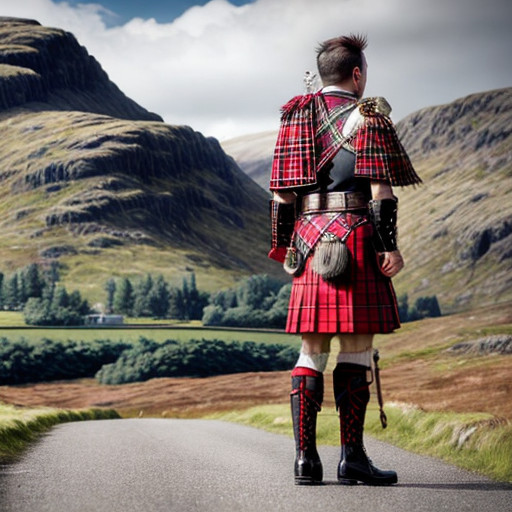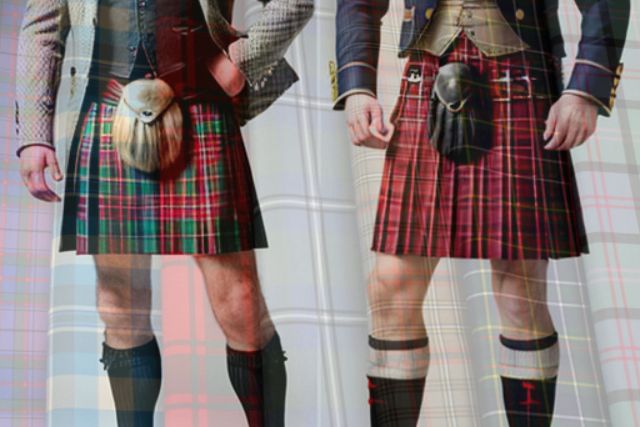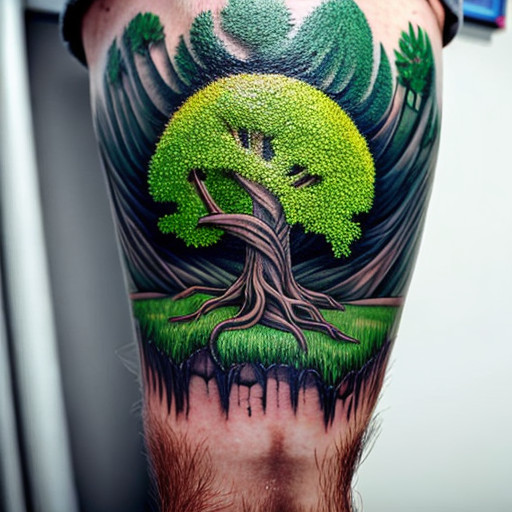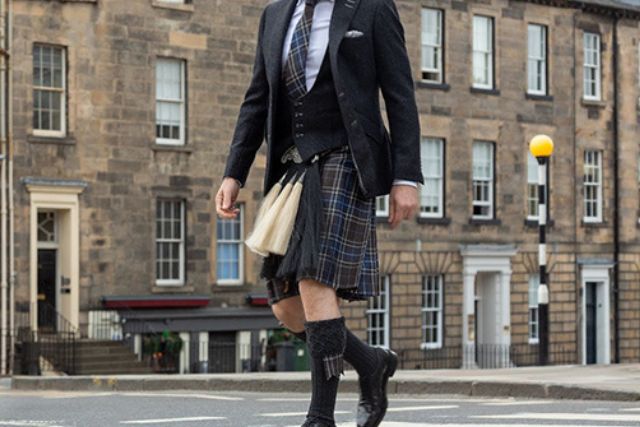In the realm of traditional Scottish attire, the kilt stands as a symbol of pride, heritage, and resilience. Woven through centuries of history, this iconic garment has evolved, adapted, and transcended cultural boundaries. This article delves deep into the captivating journey of the kilt, from its ancient origins in the Scottish Highlands to its enduring presence in modern society. Discover the rich tapestry of tartan, the impact of historical events, and the global fascination that continues to shape the future of the kilt.

Origins of the Kilt
The origins of the kilt can be traced back to the Scottish Highlands in the 16th century. The kilt, a traditional Scottish garment, was originally worn by Highland clansmen as a practical and versatile piece of clothing. Made from a single length of tartan fabric, the kilt was draped around the waist and secured with a belt or brooch. It allowed for ease of movement and provided protection against the harsh Highland climate. The tartan patterns, specific to each clan, served as a visual identifier of one’s heritage and allegiance. Over time, the kilt became increasingly associated with Scottish identity and was adopted as a symbol of national pride. Today, kilts are still worn on special occasions and formal events, preserving the rich history and tradition of this iconic Scottish garment.
Early Scottish Highland Garments
Having evolved from ancient Celtic clothing traditions, early Scottish Highland garments were characterized by their practicality and functionality. These garments were designed to withstand the harsh weather conditions and rugged terrain of the Scottish Highlands. Here are some key features of early Scottish Highland garments:
- Tartan: The use of tartan patterns was prevalent in early Scottish Highland garments. Tartan, a woven cloth with distinctive patterns of colored stripes, was used to make kilts and other clothing items. Each clan had its own unique tartan pattern, allowing for easy identification.
- Cloaks: Cloaks were commonly worn as outerwear to provide protection against the elements. Made from wool or other heavy materials, they offered warmth and served as a versatile garment that could be used as a blanket or shelter.
- Leather Accessories: Leather belts, sporran pouches, and footwear were essential components of early Scottish Highland garments. These accessories provided practicality and durability, ensuring that the wearer was well-equipped for daily activities and outdoor pursuits.
- Layering: Layering was a common practice in early Scottish Highland garments. Multiple layers of clothing were worn to provide insulation and allow for easy adjustment to changing weather conditions.
Early Scottish Highland garments were not only functional but also played a significant role in reflecting the wearer’s identity and clan affiliation.
The Introduction of the Feileadh Mòr
With its advent in the late 16th century, the Feileadh Mòr brought about a momentous transformation in Scottish Highland attire, revolutionizing the way kilts were worn and establishing a distinct cultural and sartorial identity. Also known as the Great Kilt, the Feileadh Mòr was a large piece of tartan fabric, measuring approximately six to eight yards in length and two to three yards in width. It was traditionally worn by Highlanders as a multipurpose garment, serving as a cloak, a blanket, and a sleeping bag. The Feileadh Mòr was secured around the waist with a belt, and excess fabric was draped over the shoulder or used to cover the head. This versatile garment allowed for ease of movement and provided protection against the harsh Highland weather. The introduction of the Feileadh Mòr marked a significant shift in Highland fashion, solidifying the kilt as a symbol of Scottish heritage and pride.
The Role of Tartan in Kilt History
Tartan, along with its intricate patterns and vibrant colors, has played an integral role in the evolution and symbolism of kilt history. The significance of tartan can be seen in two aspects:
- Identification and Clan Affiliation: Tartan patterns were originally used to identify different clans and families in Scotland. Each clan had its own unique tartan, allowing individuals to proudly display their heritage and allegiance. The tartan became a powerful symbol of identity and belonging.
- Social and Cultural Significance: Tartan also played a vital role in social and cultural events. It was worn during important gatherings, such as Highland games and weddings, to showcase Scottish pride and tradition. Tartan was a way for individuals to express their connection to their roots and celebrate their Scottish heritage.
The Act of Proscription and the Highland Dress
The Act of Proscription banned the wearing of traditional Highland attire, yet it failed to fully suppress the enduring influence of the Highland dress. Enacted in 1746 by the British government, the Act aimed to dismantle the power and culture of the Scottish clans after the Jacobite Rebellion. It specifically prohibited the wearing of tartan, kilts, and other traditional Highland garments. The Act was enforced for nearly four decades, causing a decline in the popularity of Highland dress. However, it did not completely eradicate the practice. Despite the ban, many Scots continued to wear their traditional dress in secret, and the Highland dress gradually regained popularity in the early 19th century. Today, the Highland dress, including the kilt, remains an important symbol of Scottish identity and heritage.
The Romanticization of the Kilt in the 19th Century
The growing popularity and idealized portrayal of the kilt in the 19th century contributed to the romanticization of Scottish culture. During this time, the kilt became widely associated with the image of the rugged Highland warrior, evoking a sense of bravery, independence, and adventure. This idealized version of the kilt was perpetuated through various mediums, including literature, art, and even stage performances.
• Fictional Works: Many novels and poems of the era featured dashing Highland heroes clad in kilts, such as Walter Scott’s “Waverley” and James Macpherson’s “Ossian.”
• Visual Representations: Romantic artists, like Sir Edwin Landseer and Horatio McCulloch, painted landscapes showcasing Highland scenery and men in kilts, further enhancing the romantic image.
• Theater Productions: The popularization of Highland-themed plays, such as “Rob Roy” and “The Lady of the Lake,” featuring actors dressed in tartans, contributed to the romanticized perception of the kilt.
This idealized portrayal of the kilt in the 19th century solidified its association with Scottish culture and contributed to its enduring romantic appeal.
The Kilt in Scottish Military History
Throughout Scottish military history, kilts were frequently worn by soldiers as a symbol of national identity and a reflection of their fierce and proud heritage. The use of kilts in the military dates back to the 16th century when Highland clans formed their own regiments. These regiments, known as the Highlanders, wore tartan kilts as part of their uniforms. The kilt provided the soldiers with freedom of movement, allowing them to navigate the rugged terrain of the Scottish Highlands more easily. Additionally, the distinctive tartan patterns of the kilts served as a means of identification, distinguishing one clan or regiment from another. The kilt continued to be worn in Scottish military units until the early 19th century when it was eventually replaced by more standardized uniforms. However, even today, kilts are still worn by certain Scottish military regiments on ceremonial occasions, showcasing the enduring connection between the kilt and Scottish military history.
The Kilt as a Symbol of Scottish Identity
As the kilt has evolved over the centuries, it has become an enduring symbol of Scottish identity, representing the rich cultural heritage and traditions of the Scottish people. The kilt holds a special place in the hearts of Scots, serving as a visual representation of their national pride. Here are a few reasons why the kilt is so deeply intertwined with Scottish identity:
- Historical Significance:
- The kilt has been worn for centuries, dating back to the 16th century, and has become an integral part of Scottish history.
- It symbolizes the resilience and bravery of Scottish warriors who fought for their land and freedom.
- Cultural Heritage:
- The kilt is deeply rooted in Scottish culture and traditions, showcasing the unique tartan patterns associated with different clans and regions.
- It is worn on special occasions, such as weddings, ceilidhs, and Highland games, further emphasizing its cultural significance.
Famous Kilts Throughout History
During significant historical events and cultural milestones, notable individuals have adorned themselves with kilts, both for practicality and as a symbol of their Scottish heritage. One famous kilt wearer was Bonnie Prince Charlie, who led the Jacobite Rising in 1745. His iconic tartan kilt became synonymous with the Scottish rebellion against the British monarchy. Another well-known figure who donned the kilt was Sir Walter Scott, a renowned Scottish writer and poet. He was instrumental in popularizing the kilt as a national symbol through his literary works. Additionally, we cannot forget about the legendary Scottish regiments, such as the Black Watch and the Royal Scots Dragoon Guards, who proudly wore kilts in battle. These kilts represented their bravery, loyalty, and connection to their Scottish roots. Today, kilts continue to be worn by influential figures, such as actors, musicians, and even politicians, as a means of celebrating Scottish culture and heritage.
The Role of Women in Kilt History
Women have played a significant role in shaping the history of kilts, contributing to their evolution and cultural significance.
- Fashion Innovation: Women have been instrumental in introducing changes to the design and style of kilts. They have brought a fresh perspective and creativity to the traditional garment, incorporating new colors, patterns, and fabrics.
- Social Advocacy: Women have also played a crucial role in promoting the cultural significance of kilts. They have organized events, such as fashion shows and festivals, to showcase the beauty and diversity of kilts. Additionally, they have used their influence to raise awareness about the historical and cultural importance of kilts, ensuring their preservation for future generations.
Through their fashion innovation and social advocacy, women have helped to keep the kilt a vibrant and cherished part of Scottish heritage.
The Influence of the Kilt on Fashion
With its unique design and cultural significance, the kilt has undeniably left an indelible mark on the world of fashion. Originally a traditional Scottish garment, the kilt has evolved over the years and has influenced various aspects of fashion. One notable influence of the kilt on fashion is its incorporation into modern menswear. Designers have embraced the kilt’s distinctive pleated construction and have incorporated it into contemporary clothing, such as skirts, trousers, and even jackets. The kilt has also influenced the use of tartan patterns in fashion, with many designers incorporating these iconic patterns into their collections. Additionally, the kilt has inspired the creation of hybrid garments, combining traditional Scottish elements with modern design techniques. Overall, the kilt’s influence on fashion is undeniable and continues to inspire designers to this day.
The Modern Adaptations of the Kilt
One significant development in the history of the kilt is the emergence of several modern adaptations that have transformed the traditional Scottish garment into a versatile and contemporary fashion choice. These modern adaptations have allowed the kilt to transcend its original purpose and become a symbol of style and individuality.
- Contemporary Fabrics: The kilt is no longer limited to traditional tartan patterns and woolen materials. Modern kilts are now available in a variety of fabrics such as denim, leather, and even camouflage, allowing individuals to express their personal style.
- Incorporation of Modern Design Elements: Modern kilts often feature innovative design elements such as asymmetrical hemlines, zippers, and pockets. These additions not only enhance the functionality of the garment but also give it a modern and edgy aesthetic.
- Versatile Styling Options: Modern kilts can be styled in various ways to suit different occasions. They can be paired with casual t-shirts for a relaxed look or dressed up with tailored shirts and blazers for a more formal ensemble.
These modern adaptations have breathed new life into the kilt, making it a fashion-forward choice for individuals looking to make a bold statement while embracing their Scottish heritage.
The Kilt in Pop Culture
How has the kilt been portrayed in popular culture and its influence on fashion trends? The kilt, a traditional Scottish garment, has made its way into popular culture and has had a significant influence on fashion trends. In movies and television shows, the kilt is often depicted as a symbol of Scottish heritage and masculinity. It is commonly associated with characters who are strong, proud, and connected to their Scottish roots. Moreover, the kilt has also been embraced by the fashion industry, with designers incorporating kilt-inspired elements into their collections. The unique design and versatility of the kilt have inspired modern interpretations and adaptations, leading to the creation of contemporary kilt-inspired clothing and accessories. This fusion of tradition and modernity has made the kilt a timeless and iconic piece in pop culture and fashion.
The Kilt’s Global Appeal
The kilt’s global appeal can be attributed to its rich history, distinctive design, and cultural significance. This traditional Scottish garment has captured the imagination of people around the world, transcending borders and becoming a symbol of Scottish heritage.
- The kilt’s appeal lies in its unique design, with its pleated fabric and tartan patterns that showcase individual clans and families. The craftsmanship and attention to detail make it a work of art.
- Its association with Scottish culture and traditions, such as bagpipe music and Highland games, adds to its allure. Many people worldwide are drawn to the romanticized image of the Scottish Highlands and wearing a kilt allows them to immerse themselves in this rich heritage.
The kilt’s global popularity can also be attributed to its versatile nature, with different variations and adaptations emerging in various countries. From traditional Scottish events to contemporary fashion runways, the kilt continues to captivate people of all backgrounds, making it a truly global phenomenon.
The Future of the Kilt
With evolving fashion trends and a growing interest in cultural heritage, the future of the kilt looks promising and filled with possibilities. The kilt, a traditional Scottish garment, has been a symbol of Scottish pride and identity for centuries. However, in recent years, it has gained popularity beyond Scotland’s borders, with people from all over the world embracing it as a fashion statement. This surge in global appeal has opened up new avenues for the kilt’s future. Designers are exploring innovative ways to modernize the kilt, experimenting with different fabrics, patterns, and styles. Additionally, there is a growing demand for sustainable fashion, and the kilt, being a durable and versatile garment, fits perfectly into this trend. The kilt’s future lies in its ability to adapt to changing fashion preferences while staying true to its rich cultural heritage.
Frequently Asked Questions
Are There Any Specific Historical Figures Who Were Known for Wearing Kilts?
There are several historical figures who were known for wearing kilts, including Scottish Highlanders, such as the clansmen and warriors of the Scottish Highlands. Additionally, Scottish monarchs, like King James IV and King James V, were also known to wear kilts.
How Did the Kilt Become a Symbol of Scottish Identity?
The kilt became a symbol of Scottish identity through a combination of historical, cultural, and political factors. Its association with Highland clans and the romanticized image of Scotland played a significant role in its adoption as a national symbol.
What Is the Significance of Tartan in Kilt History?
The significance of tartan in kilt history is rooted in the Scottish tradition of clan affiliations. Tartan patterns were used to identify specific clans, and wearing the tartan became a symbol of Scottish heritage and identity.
How Did the Act of Proscription Impact the Use of Kilts in Scotland?
The act of proscription significantly impacted the use of kilts in Scotland. It resulted in the banning of kilts and other traditional Highland attire, leading to a decline in their popularity and a gradual loss of their cultural significance.
How has the Kilt Influenced Fashion Trends Throughout History?
The kilt has influenced fashion trends throughout history by serving as a symbol of Scottish heritage and masculinity. Its unique design and cultural significance have inspired designers to incorporate elements of the kilt into contemporary fashion.
Conclusion
The history of the kilt is a fascinating journey through time, reflecting the changing cultural and social landscapes of Scotland. From its origins in early Scottish Highland garments to the modern adaptations seen today, the kilt has become a symbol of Scottish identity and tradition. Like a thread weaving through generations, the kilt has transcended borders and captivated the world with its unique and timeless charm. Its global appeal continues to grow, ensuring a vibrant future for this iconic garment.



